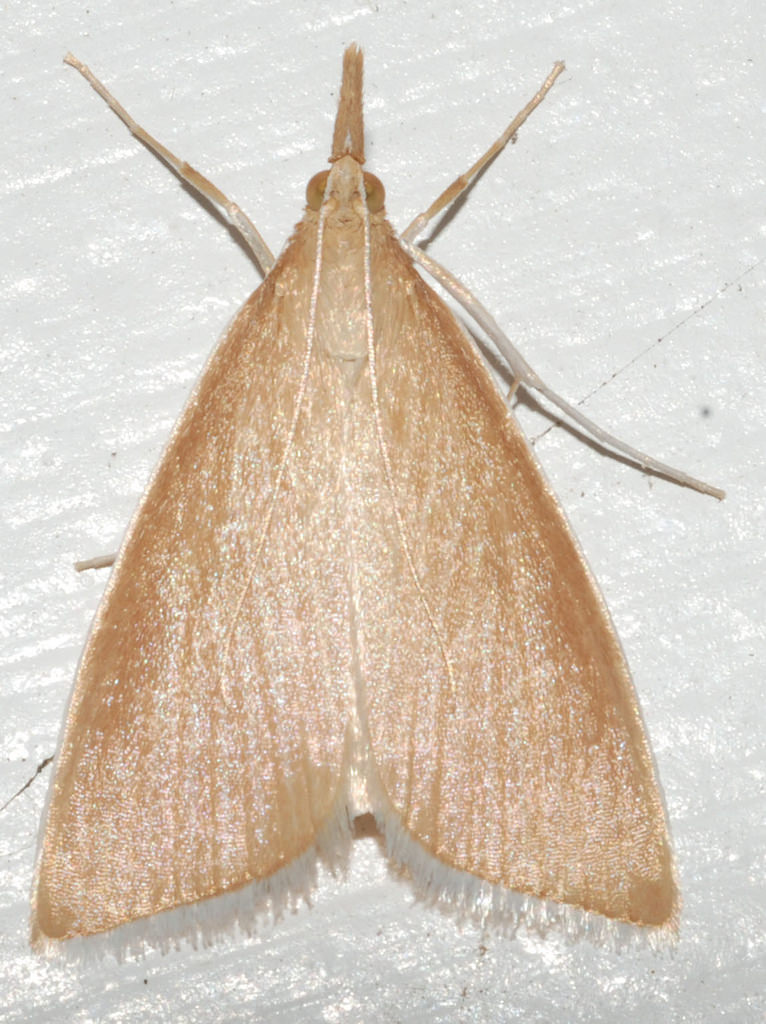Description
The Eurasian moth Sclerocona acutella superficially resembles the North American native moth Nascia acutella but differs in coloration, venation patterns on the forewings, and genital structure. Phragmites australis (Common Reed) is the food-plant of Sclerocona acutella, but that of N. acutella is unknown (Wagner et al. 2003).
Taxonomy
| Kingdom | Phylum | Class | Order | Family | Genus |
|---|---|---|---|---|---|
| Animalia | Hexapoda | Insecta | Lepidoptera | Crambidae | Sclerocona |
Synonyms
Invasion History
Chesapeake Bay Status
| First Record | Population | Range | Introduction | Residency | Source Region | Native Region | Vectors |
|---|---|---|---|---|---|---|---|
| 1998 | Established | Unknown | Introduced | Regular Resident | North America | Eurasia | Shipping(Unspecified); Ornamental(Aquatic Plant); Agriculture(Packing Material) |
History of Spread
The moth Sclerocona acutella is native to Eurasia, from Spain and Sicily north to Great Britain (as a stray) and Denmark (rare) east to Sibera, Japan, and China. The larva of this moth feeds on the lower stems and roots of the cosmopolitan plant Phragmites australis (Common Reed). In 1984, S. acutella was first collected in North America, in South Dartmouth MA, near Buzzards Bay. Since then, it has been collected in 12 locations in inland and coastal locations in northeastern North America, from MA to MD (Wagner et al. 2003). Coastal locations, where flying adults were captured, include: Thompson Island, Boston/MA/Boston Harbor; Lloyd Nature Center, South Dartmouth/MA/Buzzards Bay; Pocasset Cedar Swamp, Tiverton/RI/near the Sakonnett River, Narragansett Bay, and four locations in the Chesapeake Bay region. This moth was collected from 1 June to 21 July, with Chesapeake specimens being captured from 1 June to 14 June. This small, inconspicuous moth could have been present in North America for some time before its discovery (Wagner et al. 2003).
In the Chesapeake Bay region, Sclerocona acutella was first collected in 1998 at Taylor's Island Wildlife Management Area in Dorchester County MD on the Eastern shore of the Bay. It was collected again on the Eastern Shore in 2002 in the Hickory Point Swamp, Worcester County MD, on the Pocomoke River. In 1999, it was found on the Western Shore of the upper Bay, in Bush Wildlife Management Area, Harford County MD, on the Bush River. It was also collected beside an Atlantic coastal bay, Chincoteague Bay, on the Isle of Wight, in Worcester County MD (Wagner et al. 2003). The range fcollection sites in northeastern North America, including inland and coastal freshwater marshes and swamps, and brackish-to-salt marshes, suggests that S. acutella develops successfully in fresh to meso- or polyhaline salinities, and could colonize much of the present range of Phragmites australis.
History References- Wagner et al. 2003
Invasion Comments
Residency- Larvae of moth Sclerocona acutella feed inside the lower stems of Phragmites australis and tolerate regular flooding (Ferguson, personal communication 2001).
Ecology
Environmental Tolerances
| For Survival | For Reproduction | |||
|---|---|---|---|---|
| Minimum | Maximum | Minimum | Maximum | |
| Temperature (ºC) | ||||
| Salinity (‰) | ||||
| Oxygen | hypoxic | |||
| pH | ||||
| Salinity Range | Fresh-poly |
Age and Growth
| Male | Female | |
|---|---|---|
| Minimum Adult Size (mm) | 11.5 | |
| Typical Adult Size (mm) | 12.0 | |
| Maximum Adult Size (mm) | 12.5 | |
| Maximum Longevity (yrs) | 1.0 | 1.0 |
| Typical Longevity (yrs | 1.0 | 1.0 |
Reproduction
| Start | Peak | End | |
|---|---|---|---|
| Reproductive Season | |||
| Typical Number of Young Per Reproductive Event |
|||
| Sexuality Mode(s) | |||
| Mode(s) of Asexual Reproduction |
|||
| Fertilization Type(s) | |||
| More than One Reproduction Event per Year |
|||
| Reproductive Startegy | |||
| Egg/Seed Form |
Impacts
Economic Impacts in Chesapeake Bay
The effects of insect herbivores of Phragmites australis (Common Reed), including Sclerocona acutella, have not been studied in Chesapeake Bay or elsewhere in North America. Potentially, these introduced insects could affect the aggressive invasion of P. australis in Chesapeake Bay wetlands. Studies of these insects are needed in order to determine whether P. australis control programs need to be redesigned to preserve and enhance the effect of introduced herbivore populations (Blossey and Weber 2000; Wagner et al. 2003).
References- Blossey and Weber 2000; Wagner et al. 2003
Economic Impacts Outside of Chesapeake Bay
Insect herbivores of Phragmites australis (Common Reed), including , are considered pests of reed-beds in Europe. However, the effects of these insects on the population dynamics and abundance of P. australis has not been studied in Europe or North America. Potentially, these introduced insects could affect the aggressive invasion of P. australis in eastern North American wetlands (Blossey and Weber 2000; Wagner et al. 2003).
References- Blossey and Weber 2000
Ecological Impacts on Chesapeake Native Species
Impacts of the moth Sclerocona acutella on native Phragmites australis (Common Reed) populations are unknown.
Ecological Impacts on Other Chesapeake Non-Native Species
Insect herbivores of Phragmites australis (Common Reed), including , are considered pests of reed-beds in Europe (Blossey and Weber 2000). However, the effects of Sclerocona acutella on the population dynamics and abundance of P. australis has not been studied in Europe or North America. Potentially, these introduced insects could affect the aggressive invasion of P. australis in eastern North American wetlands (Blossey and Weber 2000; Wagner et al. 2003).
References- Blossey and Weber 2000; Wagner et al. 2003
References
2002 <i>Phragmites</i>: Common Reed. web page: http://www.invasiveplants.net/Blossey, Bernd; Weber, Joseph T. (2000) First Virginia records of four European insect herbivores of Phragmites australis., Banisteria 16: 29-35
2000 Conversations with Paul Fofonoff, about introduced moths in the Chesapeake Bay region.. None
Sterling, D. H. (1989) Sclerocona acutellus (Eversmann) (Lepidiptera: Pyralidae) new to Britain., Entomologists Gazette 40: 1-3
Wagner, David L.; Ferguson, Doug C.; Glaser, John D. (2003) Sclerocona acutella (Crambidae: Pryaustinae), naturalized along the eastern seaboard., Journal of Lepidopterist Society 57: 270-273
